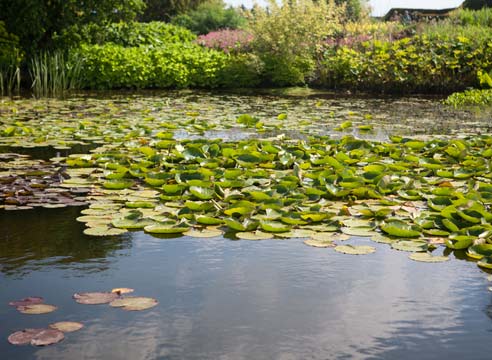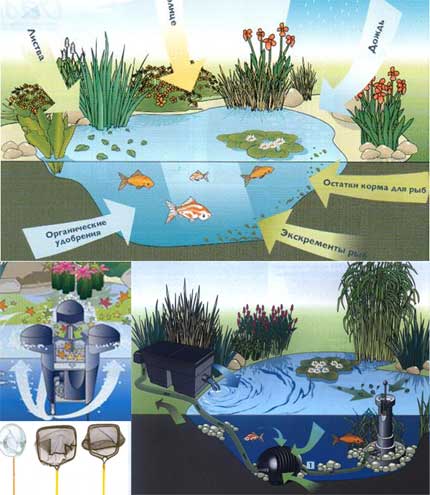Many of us know how nice summer evening sit at the pond or plunge into it in a sultry noon. After all, the ideal surface of water gives the charge of the most positive emotions and completely pacifies. At the same time, quite often such a reservoir in which there is no fish and other livelihood, it has to be cleaned of contaminants, since otherwise it will turn into a swamp with many mosquitoes and an unpleasant odor.
Content
The first thing that comes to the Mind owners is a complete replacement of water, but, making it constantly, there is a chance to go on the water supply. However, there is another method - to clean the pond with your own hands or attract specialists for this.
Why brush with water?
After the pond was filled with water, literally a few days later it can be noted active microorganisms. In addition, the wind does leaves there, dust and other polluting substances.
How to clean the water in the pond
Cleaning the ponds involves a whole range of work, which most often can only be performed by masters using special reagents and equipment. However, if you do not want to trust them with a water, you can try to clean the pond yourself, originally removing the floating garbage from the surface.
Types of ponds
In everyday life, they can be divided into several groups:
1. "Pants"
These are such water bodies whose area is less than 100 sq.m. In these ecosystems, it is rather difficult to achieve natural biofursion due to a small volume. Their activity has to maintain regular artificial filtration. In the absence of proper care, it will periodically take out outbreaks of blooms of chances and blue-green algae.
2. Ponds
These are reservoirs having a surface area of \u200b\u200b100 sq.m. up to several hectares. They can be divided into 3 main groups:
- small (100-1000 sq.m.);
- medium (1000-5000 sq.m.);
- Large (more than 5000 sq.m.).
In such ponds, it is possible to maintain natural bioravysia, but provided that the proper care is the correct settling in vegetation and fish. This reservoir is an independently functioning closed ecosystem, which is supported by the internal bioprocesses. In artificial filtration, it needs only periodically.
Pollution prevention
To prevent pollution you need to constantly care for a pond. First of all, a variety of mechanical antibodies should be excluded. If you are a biologist, then it is likely to be able to maintain its livelihood without the use of various kinds of equipment. As for the amateurs gardeners, they usually have to create cleaning using special devices.
Today, several foreign companies are presented in the market of specialized techniques for ponds:
- OASE (Germany);
- Heissner;
- Hozelock (United Kingdom);
- Amiad (Israel) and others.
At the same time, OASE, Heissner and Hozelock offer a more global spectrum of filtering equipment, and Amiad implements only mechanical installations for cleaning a large area of \u200b\u200breservoirs. For small ponds (up to 1000 liters), you can use filters of companies that specialize in the manufacture of aquarium equipment: Sera (Germany), Project (Italy), Aquael (Poland), Sacem (France), Eheim, Hagen (Canada). In their assortment, there are usually several types of filters.
How to clean the pond in the country
Methods of cleaning:
- with the help of ultraviolet radiation;
- biological;
- chemical;
- mechanical.
Mechanical cleaning
The easiest and most inexpensive method of cleaning, allowing to get rid of unnecessary garbage, algae and aquatic plants. The principle of operation of such equipment is to clean the water by passing it through a special container with a filtering substance (quartz sand, special granules or gravel). When the filter clogged - the water begins to flow worse, respectively, the time for replacing its filter element has come. If a small gravel was used as it, it can be cleaned with a thorough washing, and if the quartz sand, then it does not give in to such a cleaning. To create water pumping through the filter, special pumps are applied. They should be selected based on the volume of the pond and the filter used.
Biological cleaning
Based on the biochemical decomposition of organic elements to carbon dioxide, methane and hydrogen sulfide. Created in devices with special bacteria. Most often, this cleaning method is used in conjunction with mechanical. The biofilter chamber is filled with a porous substance that promotes the reproduction of the microorganisms of the feeding organic, which is held by the filtering material. The volume of these filters must be adjusted, taking into account the presence of fish in the pond - the greater the fish, the larger the volume there should be a filter.
Recently, a single domestic company created the installation of biological cleaning of water bodies, consisting of several plastic sections filled with crustacean plankton. It floats over the surface of the pond and filled with water, which passes through 3 cleaning sections. Oxygen-saturated and purified water is pumped up with a pump back into the deep layers of the reservoir. Installation can create water cleaning to 0.5 hectares.
Chemical cleaning
In this case, chemical reagents are added in the water, which:
- restore the necessary level of acidity;
- bind the compound of metals and ammonia;
- saturated with water oxygen;
- Dissolve algae.
Manufacturers advise very carefully to comply with the dosage, because some chemicals used in large quantities are dangerous for living in the reservoir and for humans.
Chemical cleaning can not be used if useful plants are inhabitable plants cleaning water - fontinalis, tilleya, rogol, bolotnik, etc., which are capable of saturating with oxygen.
Cleaning with ultraviolet radiation
To clear the pond from the sludge, you can use an ultraviolet radiation device, which consists of a housing inside a lamp and a special mechanism that impedes the pollution of the reservoir. To create its effective work, you should create a lamp replacement every season.
Full replacement of water
If the pond is very polluted and the filtration equipment does not provide normal water cleaning, then it should be changed:
1. Initially, you need to lower the water
2. Next transfer fish and plants to temporary storage
3. Then the walls and bottom of the reservoir cleanse from the garbage and sludge
Recommendations
The bottom Il is a mixture that is saturated with organic substances non-oxygen. It should not use it in the form of fertilizer on the plot, however, if you place the IL into the compost yam and mix it with peat, then after a while it turns out the most valuable fertilizer.
How to clean the pond from the rod?
To fully clean the pond from the rod is almost not real, but there is a chance to limit the reproduction of this plant.
Pay attention to the detesty and plants that were planted in the pond. If they were taken from a natural reservoir, then with them can get a row.
At the same time, the yard is well multiplied with a large number of nutrients in water, so try not to overflow fish, plants and twist water from garbage, dead organisms in a timely manner.
You can get rid of annoying rod with floating and underwater plants - they are able to provide her to competition in the struggle for oxygen, food and sunlight. In addition, you can run in the reservoir of carps or karas that feed on the rod.
If the rodas are very growing very much, then remove it with robbles or sacc. The resulting raw material can be applied as a compost for the fertilizer of the bed.
How to clean the pond from algae
The blue-green type of algae can be removed by several methods:
- mechanical;
- by creating limiting the factors of their growth (light, elevated temperature, excess of organic and oxygen);
- Chemical.
Also, to clear the pond from greenery, you can use a more efficient cleaning method based on the biochemical decomposition of organic elements to carbon dioxide, hydrogen sulfide and methane in order to deprive blue-green algae substrates for reproduction. For this, a complex of specially selected anaerobic and aerobic bacteria is applied.
How specialists clean the video ponds:































